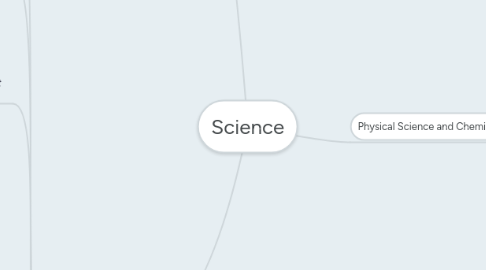
1. Life Science
1.1. Cells
1.1.1. Eukaryotic Cells
1.1.1.1. Animal Cells
1.1.1.1.1. Organelles and Important Structures
1.1.1.1.2. Cellular Respiration
1.1.1.2. Plant Cells
1.1.1.2.1. Nucleus
1.1.1.2.2. Chloroplasts
1.1.1.2.3. Photosynthesis
1.1.1.3. Fungal Cells
1.1.1.3.1. Cell Wall
1.1.2. Prokaryotic Cells
1.1.2.1. Bacteria Cells
1.1.2.1.1. Nucleolus
1.1.2.1.2. Ribsomes
1.1.2.1.3. Plasmid
1.1.2.1.4. Cell Wall
1.1.2.1.5. Flagella & Cilia
1.1.2.2. Archaea
1.1.3. Cellular Reproduction
1.1.3.1. Mitosis
1.1.3.2. Meiosis
1.2. Body Systems
1.2.1. Musculoskeletal
1.2.1.1. Muscular
1.2.1.2. Skeletal
1.2.2. Endocrine
1.2.3. Nervous
1.2.4. Respiratory
1.2.5. Digestive
1.2.6. Excretory
1.2.7. Circulatory
1.2.8. Integumentary
1.2.9. Immune
1.3. Community
1.3.1. Natural Selection
1.3.2. Predator
1.3.3. Prey
1.3.4. Trait
1.3.5. Evolution
1.4. Genetics
1.4.1. DNA
1.4.2. Chromosomes
1.4.3. Gene
1.4.4. Codon
1.4.5. Nucleotide
1.4.6. Heredity
1.4.6.1. Phoneme
1.4.6.2. Punnett Square
1.4.6.3. Dominance and Recessive
1.5. Ecology
1.5.1. Food Chain
1.5.1.1. Primary Producers
1.5.1.2. Decomposers
1.5.1.3. Primary Consumers
1.5.1.4. Secondary Consumers
1.5.1.5. Tertiary Consumers
1.5.2. Relationships
1.5.2.1. Mutualism
1.5.2.2. Commensalism
1.5.2.3. Parasitism
2. Earth/Space Science
2.1. Distances
2.1.1. Light Year
2.1.2. Parallax
2.1.3. Astronomical Unit
2.2. Solar System
2.2.1. Star
2.2.2. Planets
2.2.2.1. Formation
2.2.2.2. Earth
2.2.2.2.1. Layers
2.2.2.2.2. Erosion
2.2.2.2.3. Weathering
2.2.2.2.4. Atmosphere
3. Physical Science and Chemistry
3.1. Fundamental Forces
3.1.1. Gravity
3.1.2. Weak Force
3.1.3. Strong Force
3.1.4. Electromagnetism
3.2. Laws of Motion
3.2.1. Newton's First Law of Motion
3.2.2. Newton's Second Law of Motion
3.2.3. Newton's Third Law of Motion
3.3. Nature of Science
3.3.1. General Lab Safety
3.3.2. Variables
3.3.3. Scientific Method
3.3.4. Data
3.4. Chemical Reactions
3.4.1. Stoichiometry
3.4.2. Molarity
3.4.3. Periodic Table
3.4.4. Bonds
3.4.5. Reaction Types
3.5. Structure of the Atom
3.5.1. Electrons
3.5.2. Protons
3.5.3. Neutrons
3.5.4. Nucleus

